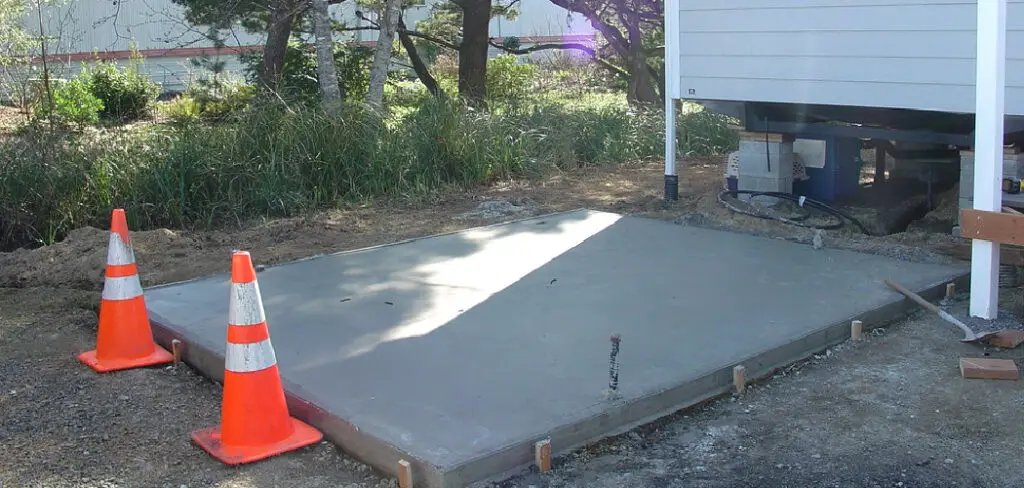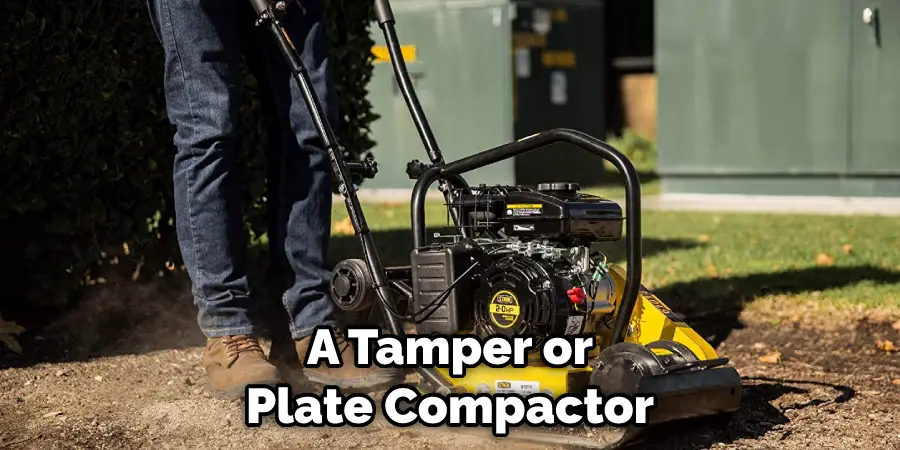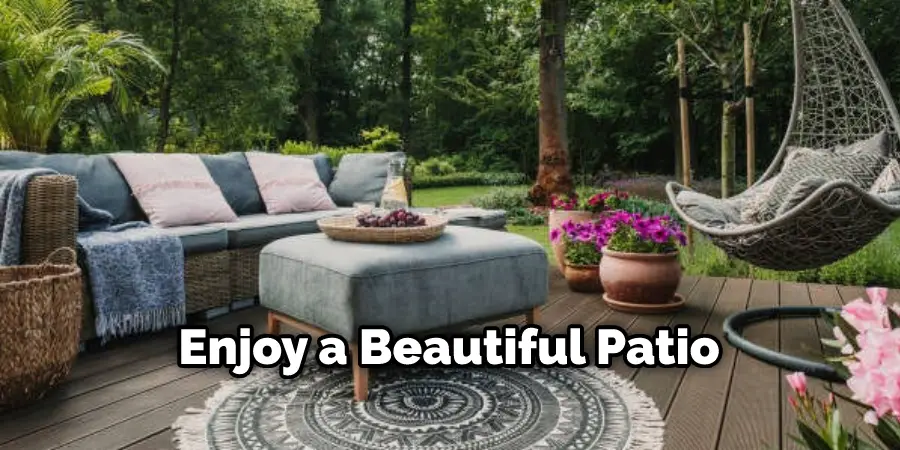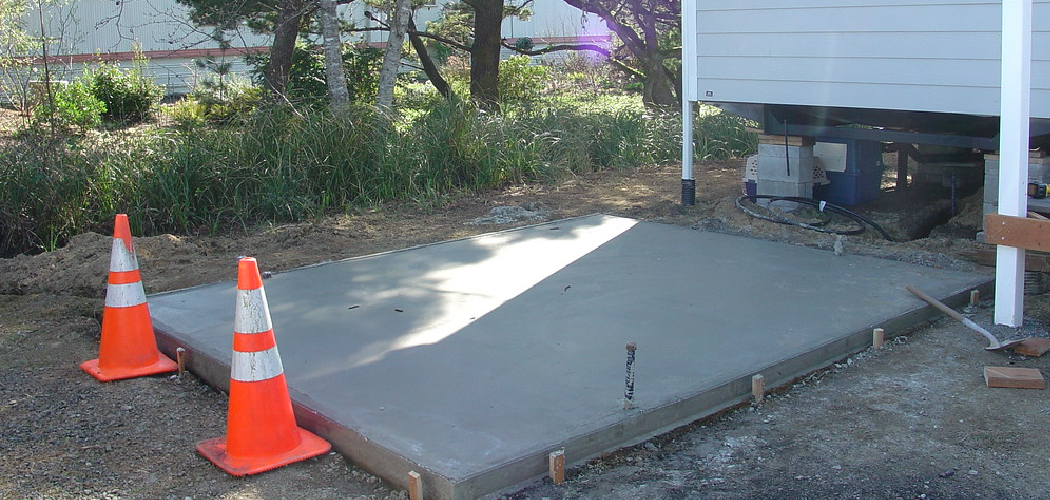Creating a beautiful patio in your backyard doesn’t have to be difficult or expensive – and it definitely does not require the use of cement! With some research and dedication, you can lay an impressive outside space perfect for entertaining guests with ease.

We’ll explore the many different methods you can employ to install a patio without cement that will last. So if you’re ready to create an amazing outdoor experience without relying on complex construction processes, read on! Here is a guide on how to lay a patio without cement.
Needed Tools and Supplies
Before you start laying your patio, you’ll need to gather the necessary tools and supplies. For a basic patio setup without cement, you’ll need:
- Landscape fabric
- Gravel or crushed stone base
- Sand for leveling
- Tampers
- Edging material such as wood, plastic, or metal Pavers (concrete, brick, flagstone)
10 Steps on How to Lay a Patio Without Cement
Step 1: Measuring
Measure the area where you will lay the patio. It is an important first step and will help you determine the number of materials you need. Measure the length and width of the space you plan to use.
Step 2: Preparing the Area
Prepare the area by removing any grass, weeds, or debris that may be present. If there are trees or shrubs in the way, make sure to remove them as well carefully. You may also need to level out any bumps or uneven areas.
Step 3: Installing the Landscape Fabric
Install a layer of landscape fabric over the area you are preparing for the patio. This will help keep weeds and grass from growing up through the patio, making it look neater and last longer. Secure the edges of the fabric with staples or stones to make sure it doesn’t move.

Step 4: Create a Gravel or Crushed Stone Base
Create a gravel or crushed stone base by evenly spreading and compacting the material across the area using a tamper. Make sure to level out the surface before moving on to the next step.
Step 5: Installing Sand for Leveling
Install a layer of sand over the gravel or crushed stone base. This will give you an even surface to work on when laying the pavers. Use a tamper to level out the sand and make sure it is even across the entire area.
Step 6: Installing Edging Material
Once you have leveled out the sand, install the chosen edging material. This will help keep the pavers in place and also add an aesthetic element to your patio. Leveling up the material is necessary to ensure a neat and even finish.
Step 7: Installing the Pavers
Start laying the pavers one at a time, working in small sections at a time. Make sure to use plenty of sand between the joints to keep them level and even. Work your way around the area until you have laid all the pavers.
Step 8: Filling Joints with Sand
Fill the joints between the pavers with sand and use a broom to sweep it into the spaces. Make sure to wipe away any excess sand on top of the pavers. This will make them look neater and last longer.
Step 9: Compacting the Pavers
Compact the pavers with a tamper or plate compactor to ensure they stay in place. Make sure to start from the center and work your way outwards. This will help prevent any shifting or unevenness.

Step 10: Finishing Up
Once you have finished installing the patio, add any plants or decorations to complete the look. You can also install a pergola or an outdoor kitchen to make your patio even more inviting.
You Can Check It Out to Extend Patio Slabs
10 Tips for Taking Care of the Patio Without Cement
- Make sure to put a good layer of weed block fabric down before you start. This will help prevent weeds from growing between the pavers and creating an uneven surface.
- Lay your stones out in the pattern that you want them to be in before you begin setting them. This will give you an idea of what it will look like when you’re finished.
- Take out any grass or other debris from the area you plan to lay your patio stones in. This will make it easier to create a level surface and will also help keep weeds away from your patio.
- Place the pavers on top of the bedding sand, making sure that each stone is level and stable. If a paver has an uneven surface, you can use more sand or other material to make it even before setting it down.
- You will need to compact the soil underneath the stones to give them stability and prevent them from shifting or falling over time. You can use a hand tamper or rent a plate compactor to do this.
- Spread additional sand over the top of the patio stones and use a broom to sweep it in between them. This will help hold them together better and keep weeds from growing up through the cracks.
- After the sand is swept in, you can use a garden hose to wet down the patio stones and help set them into place. A garden hose also works well for cleaning off any dirt or debris that may have gotten onto the patio.
- Install edging around the perimeter of your patio to keep the pavers in place and give it a neat look. This can be done using plastic edging, metal edging, or even stones.

Costing of Laying a Patio Without Cement
The cost of laying a patio without cement will depend on the type of stones you choose and the size of your patio. Generally, larger patios tend to be more expensive since more materials are required. The cost of professional labor will also vary depending on your location and how complex the project is.
You can also save money by purchasing stones from a home improvement store or online. These stones are usually less expensive than those purchased from a specialty stone supplier.
In addition to the cost of the materials, you will also need to factor in the cost of tools such as a plate compactor and hand tamper. Depending on the complexity of your project, you may also need to rent additional equipment.
Finally, you will also need to factor in the cost of any sealer or protective coating that you choose to use on your patio. This could add up depending on the type and size of your patio.
Overall, laying a patio without cement can be an affordable way to enhance your outdoor living space while saving money. With the right preparation, materials, and tools, you can create a beautiful patio without breaking the bank.
The Longevity of Patio Without Cement
The longevity of a patio without cement will depend on how well it is maintained over time. In order to ensure the longest lifespan for your patio, you should make sure to clean it regularly and seal it when necessary. This will help protect the stones from dirt, moisture, and weeds that could affect the structure and stability of the patio.
In addition, you should also regularly check for any shifting or loose stones and repair them as soon as possible. This will help keep your patio looking its best and ensure that it lasts for many years to come.
Overall, a properly installed and maintained patio without cement can last for many years if taken care of properly. With the right materials, tools, and maintenance techniques, you can enjoy a beautiful patio for years to come.
The Benefits of Patio Without Cement Patio without cement has many benefits that make it an ideal choice for any outdoor living space. Firstly, it is less expensive than other patio options, such as paving stones or concrete. This makes it a great option for those with a limited budget.
In addition, it is much easier to install than other patio options and can be done by most people with basic DIY skills. The stones can also be easily moved or replaced if necessary, which makes it easy to update the look of your patio over time.

Finally, patio without cement is much more environmentally friendly than other options. There are no harsh chemicals used in the installation, and the stones can be recycled or reused if necessary.
Conclusion
With the right tools and a bit of elbow grease, you can lay a patio in your own backyard without cement! Not only will this save you money in the long run, but it can prove to be a fun and rewarding project as well. Whether you choose to do it with concrete blocks, slate tiles, wood, or some combination of the above – laying a patio without cement is one surefire way to add value and beauty to your home.
And to do it easily, follow the steps on how to lay a patio without cement. And if you take care of your finished product with regular maintenance and repairs, it will stand the test of time – just like cement ones! Now that you’ve read this article, what are you waiting for? Get out there and start laying your dream patio today!
You Can Check It Out to Keep Patio Rug in Place
About
Outdoor Fixes is a distinguished figure in the world of Diy design, with a decade of expertise creating innovative and sustainable Diy solutions.
His professional focus lies in merging traditional craftsmanship with modern manufacturing techniques,
fostering designs that are both practical and environmentally conscious. As the author of diy,
outdoorfixes delves into the art and science of outdoorfixes-making, inspiring artisans and industry professionals alike.
Education RMIT University
(Melbourne, Australia) Associate Degree in Design (Outdoor Fixes) Focus on sustainable design, industry-driven projects,
and practical craftsmanship. Gained hands-on experience with traditional and digital manufacturing tools, such as CAD and CNC software.
Nottingham Trent University
(United Kingdom) Bachelor’s in outdoorfixes.com and Product Design (Honors) Specialized in product design with a focus on blending creativity with production
techniques. Participated in industry projects, working with companies like John Lewis and Vitsoe to gain real-world insights.
Publications and Impact
In diy, Outdoor Fixes his insights on indoor design processes, materials, and strategies for efficient production.
His writing bridges the gap between artisan knowledge and modern industry needs, making it a must-read for both budding designers and seasoned professionals.

